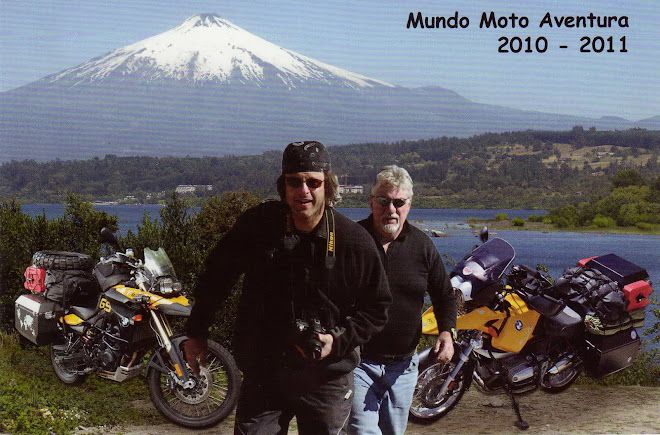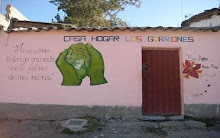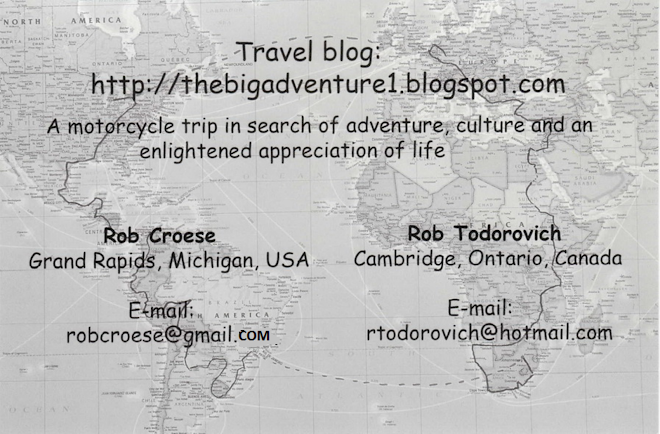RobT: Today was spent mostly on gravel roads, about 300 km of flat, barren landscape on both sides of the road. Fairly decent gravel roads, except the dips where water usually travels across during the rains. In these spots we usually encountered soft sand and lose stones. We left Karasburg for road C10 towards Ai-Ais at Fish River Canyon. Once we got there we took the rim road to Hobas, the main park entrance, hoping to see some of the canyon along the way. We didn’t see anything except huge pyramids of lose rocks that looked like they were deposited by large dump trucks. We got to the park gate in the blistering heat. Sweat was literally pouring off my forehead and dripping to the ground. We were both starting to feel the effects of the intense heat even though we were drinking lots of water. We laughed as we commented on how we both looked at our heated grip switch, thinking that it was turned on accidentally, it was that hot!
RobC on the nice gravel roads
These signs indicated a dip in the road where water may be ... if no water then sand was a sure bet.
Namibian desert on the way to Fish River Canyon.
The only way to view the canyon was from the main lookout 10 km from the gate. Day hikes into the canyon are strictly prohibited. They only offer a 5-day, 85 km hike through the canyon from Hobas to Ai-Ais while accompanied by a guide and during certain times of the year. You also need a doctor’s note stating you are fit enough to endure the hike. Supposedly, Fish River Canyon is the second largest canyon in the world at 160 km long and 27 km at its widest point; the Grand Canyon being the largest.
The canyon from the main lookout in Hobas
Another view.
RobT
RobC
In the interest of saving some time, we headed to Keetmanshoop for the night but we needed to find out the condition of the gravel road ahead, so we stopped at the Canyon Roadhouse. This is a unique place on the gravel road in the middle of nowhere. The first thing you see is a bunch of old, rusted vehicles artistically placed around the premises and even inside the main building. The structure was a huge “shed,” the inside a restaurant and bar with tables scattered amongst even more relics from an International Harvester truck, an old Land Rover, a steam engine and several old cars. Lots of antique signs decorated the walls. Very cool place.
We inquired about the gravel road short cut to Keetmanshoop, which was going to save us 150 km. The lady said the road was in fine shape, but once you came to the fork, turn right and after a few kilometers you will go over a dam, as the road will probably be closed at the point. Take the road on top of the dam and it will link up back to the road. She also said that, hopefully, they will have posted a sign of some sort so you don’t waste time by having to turn around. Sure enough, there was a sign. We took to the road, only to notice huge storm clouds in the distance. Not knowing what the weather does in these parts and how the intense storms cause rivers to rise quickly, we turned back to the Roadhouse and sat out the rain. (Note: there are very few bridges in Namibia. Roads usually run through the rivers and most of the time there is a concrete slab across the river, but if the water is high, there is no way you can ride across.)
After a meal we took a look at the skies. Seemed okay, so we set out. The roads were in good shape and we seemed to be skirting around the storm. We were making progress traveling along at 90 kph until we saw nothing but a black wall approaching us fast. Quickly slowing down we realized it was a sand storm. It was like driving into a blizzard of sand! Moments later it passed and we were able to move on. Wow!
We inquired about the gravel road short cut to Keetmanshoop, which was going to save us 150 km. The lady said the road was in fine shape, but once you came to the fork, turn right and after a few kilometers you will go over a dam, as the road will probably be closed at the point. Take the road on top of the dam and it will link up back to the road. She also said that, hopefully, they will have posted a sign of some sort so you don’t waste time by having to turn around. Sure enough, there was a sign. We took to the road, only to notice huge storm clouds in the distance. Not knowing what the weather does in these parts and how the intense storms cause rivers to rise quickly, we turned back to the Roadhouse and sat out the rain. (Note: there are very few bridges in Namibia. Roads usually run through the rivers and most of the time there is a concrete slab across the river, but if the water is high, there is no way you can ride across.)
After a meal we took a look at the skies. Seemed okay, so we set out. The roads were in good shape and we seemed to be skirting around the storm. We were making progress traveling along at 90 kph until we saw nothing but a black wall approaching us fast. Quickly slowing down we realized it was a sand storm. It was like driving into a blizzard of sand! Moments later it passed and we were able to move on. Wow!
One of the many relics in front of the Canyon Roadhouse.
Missed this storm, but I'm sure we'll run head long into another down the road.
There was no way across this road so we rode across the top of the dam.
The dam upstream from the road.



















If you guys are running into that extreme kind of heat regularly, try to find coconut water (WATER, not milk) to put in your camelbacks. It naturally balances your electrolytes and contains potassium and magnesium. It's the only thing I take to the beach in summer. Trust me, look into it :)
ReplyDelete